浙江大学 年拟升教授研究员)人选条件统计一览表任现职
浙江大学申报教授研究员职务人员主要业绩任现职以来
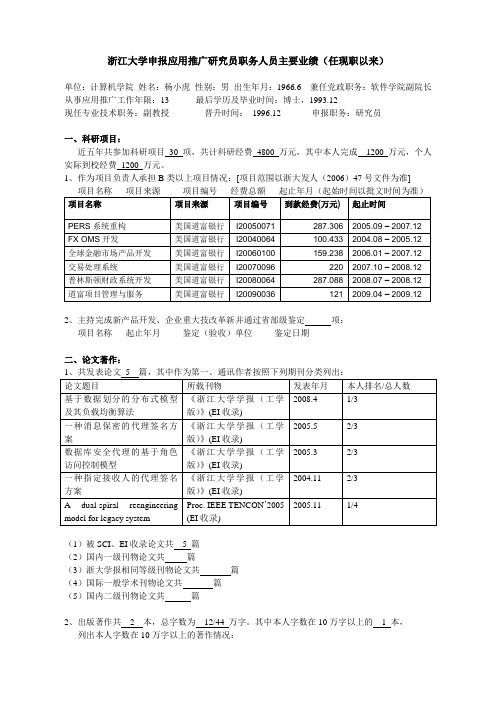
浙江大学申报应用推广研究员职务人员主要业绩(任现职以来)单位:计算机学院姓名:杨小虎性别:男出生年月:1966.6 兼任党政职务:软件学院副院长从事应用推广工作年限:13 最后学历及毕业时间:博士,1993.12现任专业技术职务:副教授晋升时间:1996.12 申报职务:研究员一、科研项目:近五年共参加科研项目30项,共计科研经费4800 万元,其中本人完成1200 万元,个人实际到校经费1200 万元。
1、作为项目负责人承担B类以上项目情况:[项目范围以浙大发人(2006)47号文件为准]2、主持完成新产品开发、企业重大技改革新并通过省部级鉴定项:项目名称起止年月鉴定(验收)单位鉴定日期二、论文著作:(1)被SCI、EI收录论文共 5 篇(2)国内一级刊物论文共篇(3)浙大学报相同等级刊物论文共篇(4)国际一般学术刊物论文共篇(5)国内二级刊物论文共篇2、出版著作共 2 本,总字数为12/44 万字。
其中本人字数在10万字以上的 1 本,列出本人字数在10万字以上的著作情况:3、总结报告篇,总字数为万字。
按照下列格式列出:报告题目总字数用途三、成果奖励:1、共获成果奖2 项,请按下列获奖类别分别列出[获奖级别范围以浙大发人(2006)47号文为准]:(1)国家级奖 1 项(2)省部级一、二等奖 1 项(3)省部级三等奖项(4)省部级优秀奖项2、作为技术人员获国家发明专利项:专利名称专利编号专利单位专利批号本人排名/总人数四、社会经济效益(为技术负责人主持完成新产品开发,重大技改、革新项目等所产生的经济效益):2001年起与全球金融服务巨头——美国道富银行(State Street Corporation)合作成立浙江大学道富技术中心并担任中心主任,领导团队积极开展全球化金融软件系统研究开发,从十几人发展成为上千人的全球化金融软件研发中心,近五年团队到校经费超4800万元,其中本人主持项目经费超1200万元,在大容量高性能高并发分布式软件架构、遗留系统再工程等方面取得突出成绩。
浙江大学申报教授研究员职务人员主要业绩任
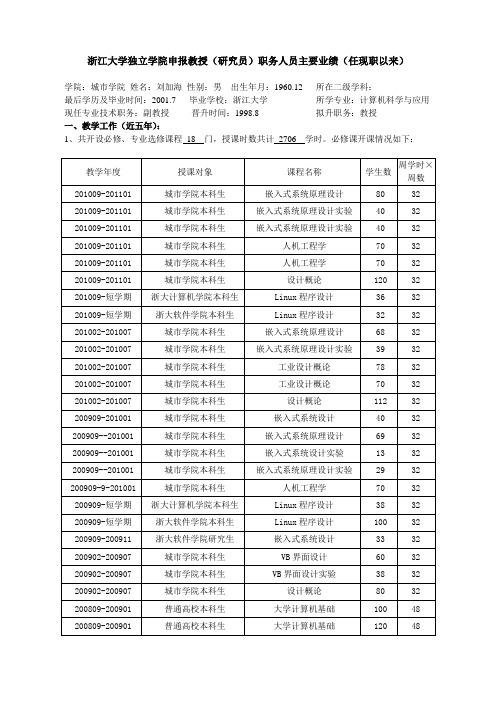
浙江大学独立学院申报教授(研究员)职务人员主要业绩(任现职以来)学院:城市学院姓名:刘加海性别:男出生年月:1960.12 所在二级学科:最后学历及毕业时间:2001.7 毕业学校:浙江大学所学专业:计算机科学与应用现任专业技术职务:副教授晋升时间:1998.8 拟升职务:教授一、教学工作(近五年):1、共开设必修、专业选修课程18 门,授课时数共计2706 学时。
必修课开课情况如下:教学年度授课对象课程名称学生数周学时×周数201009-201101 城市学院本科生嵌入式系统原理设计80 32 201009-201101 城市学院本科生嵌入式系统原理设计实验40 32 201009-201101 城市学院本科生嵌入式系统原理设计实验40 32 201009-201101 城市学院本科生人机工程学70 32 201009-201101 城市学院本科生人机工程学70 32 201009-201101 城市学院本科生设计概论120 32 201009-短学期浙大计算机学院本科生Linux程序设计36 32 201009-短学期浙大软件学院本科生Linux程序设计32 32 201002-201007 城市学院本科生嵌入式系统原理设计68 32 201002-201007 城市学院本科生嵌入式系统原理设计实验39 32 201002-201007 城市学院本科生工业设计概论78 32 201002-201007 城市学院本科生工业设计概论70 32 201002-201007 城市学院本科生设计概论112 32 200909-201001 城市学院本科生嵌入式系统设计40 32 200909--201001 城市学院本科生嵌入式系统原理设计69 32 200909--201001 城市学院本科生嵌入式系统设计实验13 32 200909--201001 城市学院本科生嵌入式系统原理设计实验29 32 200909-9-201001 城市学院本科生人机工程学70 32 200909-短学期浙大计算机学院本科生Linux程序设计38 32 200909-短学期浙大软件学院本科生Linux程序设计100 32 200909-200911 浙大软件学院研究生嵌入式系统设计33 32 200902-200907 城市学院本科生VB界面设计60 32 200902-200907 城市学院本科生VB界面设计实验38 32 200902-200907 城市学院本科生设计概论80 32 200809-200901 普通高校本科生大学计算机基础100 48 200809-200901 普通高校本科生大学计算机基础120 48200809-2000811 浙江大学软件学院研究生嵌入式系统设计30 32 200803-200807 普通高校本科生C语言程序设计40 96 200803-200807 硕士专业学位研究生计算机信息安全16 32 200803-200807 普通高校本科生C++程序设计基础与实验109 64 200803-200807 普通高校本科生C++程序设计基础与实验67 64 200803-200807 普通高校本科生C++程序设计基础与实验30 64 200711-200801 硕士专业学位研究生嵌入式程序设计45 32 200709-200801 普通高校本科生大学计算机基础78 48 200709-200801 普通高校本科生大学计算机基础89 48 200709-200801 普通高校本科生网络技术基础35 48 200709-200801 普通高校本科生网络技术基础33 48200707-200707 普通高校本科生课程综合实践(Linux C程序设计)107 32200707-200707 普通高校本科生课程综合实践(Linux C程序设计)97 32200705-200707 普通高校本科生Visual C++程序设计52 40 200703-200707 普通高校本科生C++程序设计基础与实验127 64 200703-200707 普通高校本科生C程序设计基础与实验93 64 200703-200707 普通高校本科生Visual C++程序设计88 64 200703-200707 普通高校本科生可视化科学计算MATLAB语言71 64 200703-200707 普通高校本科生可视化科学计算MATLAB语言23 40 200703-200704 普通高校本科生Linux应用技术基础15 40 200611-200701 普通高校本科生可视化程序设计90 40 200611-200701 硕士专业学位研究生嵌入式中间件37 32 200609-200701 普通高校本科生大学计算机基础105 32 200609-200701 普通高校本科生大学计算机基础94 32 200609-200611 普通高校本科生Visual c++程序设计88 40 200609-200611 硕士专业学位研究生嵌入式程序设计54 32 200602-200606 普通高校本科生C语言程序设计基础及实验133 64 200602-200606 普通高校本科生C语言程序设计基础及实验107 64 200602-200605 普通高校本科生Visual c++程序设计91 40 200602-200605 普通高校本科生可视化程序设计90 40200509-200601 普通高校本科生大学计算机基础92 48 200509-200511 普通高校本科生Visual c++程序设计100 45 200509-200511 普通高校本科生可视化程序设计88 40 200505-200507 普通高校本科生多媒体程序设计97 45 200502-200507 普通高校本科生C语言程序设计基础及实验108 68 200502-200507 普通高校本科生C语言程序设计基础及实验107 682、指导本科生毕业论文(设计)城市学院 14人(请列出姓名、专业、年级)姓名专业年级倪维欣信息工程(通信工程)2005级蔡雁冰信息工程(通信工程)2005级罗旭焕自动化2005级孙添城电子信息工程2005级罗友荣信息工程(通信工程)2005级陆麒电子信息工程2005级范梦欧电子科学与技术2006级李炜信息工程(通信工程)2006级林俊豪信息工程(通信工程)2006级徐梦婕信息工程(通信工程)2006级余敏儿信息工程(通信工程)2006级戚林园信息工程(通信工程)2006级王芳信息工程(通信工程)2006级朱凌佳信息工程(通信工程)2006级3、指导硕士研究生毕业论文(设计) 67 人(请列出姓名、专业、年级)其中科学硕士姓名专业年级王丽人体科学硕士研究生2004级崔泰铭人体科学硕士研究生2005级杨镐人体科学硕士研究生2006级周敏燕人体科学硕士研究生2009级赵王芳人体科学硕士研究生2010级软件工程硕士姓名专业年级吴双网络方向硕士研究生2007级李铮网络方向硕士研究生2007级沈佳网络方向硕士研究生2007级邵威为嵌入式系统设计方向硕士研究生2007级陆亦雄嵌入式系统设计方向硕士研究生2007级苏琦嵌入式系统设计方向硕士研究生2007级许杰嵌入式系统设计方向硕士研究生2007级刘坷炙嵌入式系统设计方向硕士研究生2007级童飞文嵌入式系统设计方向硕士研究生2007级张琳嵌入式系统设计方向硕士研究生2007级卢常瑜嵌入式系统设计方向硕士研究生2007级何娅嵌入式系统设计方向硕士研究生2007级陈锐嵌入式系统设计方向硕士研究生2007级潘建磊嵌入式系统设计方向硕士研究生2007级陈东国嵌入式系统设计方向硕士研究生2007级江帆网络工程与管理硕士研究生2008春陈景荣网络工程与管理硕士研究生2008春潘旭鸣网络工程与管理硕士研究生2008春王建中网络工程与管理硕士研究生2008春赵立软件项目管理方向硕士研究生2008春车杨软件项目管理方向硕士研究生2008春李新奇网络方向硕士研究生2008春冯志豪网络方向硕士研究生2008秋苏东伟网络方向硕士研究生2008秋李琼网络方向硕士研究生2008秋张逾网络方向硕士研究生2008秋周荣斌网络方向硕士研究生2008秋杨建仕网络方向硕士研究生2008秋范小艳网络方向硕士研究生2008秋王琳琢网络方向硕士研究生2008秋林国洋嵌入式系统设计方向硕士研究生2008秋杨倩倩嵌入式系统设计方向硕士研究生2008秋段剑芳嵌入式系统设计方向硕士研究生2008秋陈李嵌入式系统设计方向硕士研究生2008秋陈吉嵌入式系统设计方向硕士研究生2008秋周宇峰嵌入式系统设计方向硕士研究生2008秋周育锋嵌入式系统设计方向硕士研究生2008秋陈芳委嵌入式系统设计方向硕士研究生2008秋朱云川嵌入式系统设计方向硕士研究生2008秋杨怀忠嵌入式系统设计方向硕士研究生2008秋王籽晰商务智能方向硕士研究生2008秋赵辉商务智能方向硕士研究生2008秋王平商务智能方向硕士研究生2008秋吕良禹软件工程方向硕士研究生2008秋管彬商务智能方向硕士研究生2008秋邱雨铃商务智能方向硕士研究生2008秋骆绍开嵌入式系统设计方向硕士研究生2009秋陈题芳嵌入式系统设计方向硕士研究生2009秋许叶华嵌入式系统设计方向硕士研究生2009秋杨茂林嵌入式系统设计方向硕士研究生2009秋王勇嵌入式系统设计方向硕士研究生2009秋姬璟嵌入式系统设计方向硕士研究生2009秋唐继元嵌入式系统设计方向硕士研究生2009秋盛杰嵌入式系统设计方向硕士研究生2009秋余煜峰嵌入式系统设计方向硕士研究生2009秋郑林卫嵌入式系统设计方向硕士研究生2009秋何西嵌入式系统设计方向硕士研究生2009秋沈志豪嵌入式系统设计方向硕士研究生2009秋李根商务智能方向硕士研究生2009秋竺鹏东商务智能方向硕士研究生2009秋陈妙杰商务智能方向硕士研究生2009秋陈胜君商务智能方向硕士研究生2009秋4、协助指导博士研究生1人(请列出姓名、专业、年级)姓名专业年级杨镐应用心理学博士生2008级二、科研项目1、共参加科研项目8 项,共计科研经费11 万元,其中本人完成11 万元。
浙江大学申报教授(研究员)职务人员主要业绩(任现职以来)

Y2080045
8万
8万
2009-2010年
磷酸酯分子与羟基磷灰石晶面间的相互作用及其对牙釉质粘结强度的影响
国家自然基金
20973152
30万
30万
2010-2012年
纳米材料在初龋生物矿化中的应用研究
浙江省科技厅
20110565
15万
15万
2011-2013年
牙本质粘接持久性的研究
浙江省自然基金
1985.8-浙江医科大学附属第一医院口腔科住院医师(1985.8-)主治医师(1991.12-)副主任医师(1998.9-)主任医师(2003.12-今)
1980.9-1985.7浙江医科大学口腔系学生,同年毕业,获医学学士学位
二、任现职以来主要学术成就、创新成果及其学术价值(限500字)
某些磷酸酯对羟基磷灰石和牙釉质不仅有脱钙作用,而且有化学吸附。前者形成可溶性的磷酸酯-羟基磷灰石复合物,后者形成难溶性的磷酸酯-羟基磷灰石复合物。底涂-冲洗可以去除可溶性的复合物,保留化学吸附层(难容性的复合物),并对短期和长期牙釉质粘接强度作出显著的贡献。同时,酸蚀获得的微机械锁结协同化学粘接也能增强牙釉质的粘接强度。底涂-冲洗方法,或酸蚀-冲洗后再底涂-冲洗可以作为一种新型的牙釉质粘接方法。
牙本质粘结剂对离体牙齿的牙本质小管具有一定的封闭作用,且与所用粘接剂相关。进一步临床研究发现牙本质粘结剂具有一定的脱敏效果,脱敏效果也与所用的粘接剂相关。唾液污染能显著地降低自酸蚀粘结剂的粘接强度,水汽冲洗或水汽冲洗后再涂粘结剂可以显著地提高粘接强度。对唾液污染的敏感程度和水汽冲洗去污染的恢复程度均与粘接剂相关。
论文题目所载刊物发表年月本人排名/总人数是否通讯作者影响因子
浙江大学申报教授研究员职务人员主要业绩任现职以来
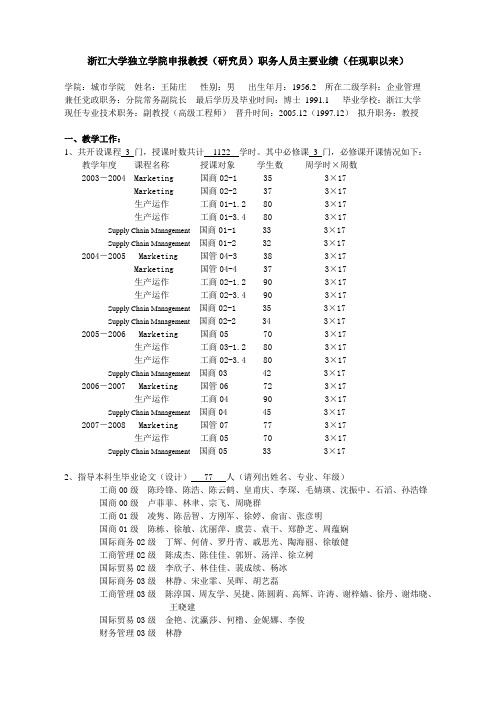
浙江大学独立学院申报教授(研究员)职务人员主要业绩(任现职以来)学院:城市学院姓名:王陆庄性别:男出生年月:1956.2 所在二级学科:企业管理兼任党政职务:分院常务副院长最后学历及毕业时间:博士1991.1 毕业学校:浙江大学现任专业技术职务:副教授(高级工程师)晋升时间:2005.12(1997.12)拟升职务:教授一、教学工作:1、共开设课程3 门,授课时数共计1122 学时。
其中必修课3 门,必修课开课情况如下:教学年度课程名称授课对象学生数周学时×周数2003-2004 Marketing 国商02-1 35 3×17Marketing 国商02-2 37 3×17生产运作工商01-1.2 80 3×17生产运作工商01-3.4 80 3×17Supply Chain Management国商01-1 33 3×17Supply Chain Management国商01-2 32 3×172004-2005 Marketing 国管04-3 38 3×17Marketing 国管04-4 37 3×17生产运作工商02-1.2 90 3×17生产运作工商02-3.4 90 3×17Supply Chain Management国商02-1 35 3×17Supply Chain Management国商02-2 34 3×172005-2006 Marketing 国商05 70 3×17生产运作工商03-1.2 80 3×17生产运作工商02-3.4 80 3×17Supply Chain Management国商03 42 3×172006-2007 Marketing 国管06 72 3×17生产运作工商04 90 3×17Supply Chain Management国商04 45 3×172007-2008 Marketing 国管07 77 3×17生产运作工商05 70 3×17Supply Chain Management国商05 33 3×172、指导本科生毕业论文(设计) 77 人(请列出姓名、专业、年级)工商00级陈玲锋、陈浩、陈云鹤、皇甫庆、李琛、毛婧瑛、沈振中、石滔、孙浩锋国商00级卢菲菲、林聿、宗飞、周晓群工商01级凌隽、陈岳智、方刚军、徐婷、俞宙、张彦明国商01级陈栋、徐敏、沈丽萍、虞芸、袁干、郑静芝、周蕴娴国际商务02级丁辉、何倩、罗丹青、戚思光、陶海丽、徐敏健工商管理02级陈成杰、陈佳佳、郭妍、汤洋、徐立树国际贸易02级李欣子、林佳佳、裴成续、杨冰国际商务03级林静、宋业霏、吴晖、胡艺磊工商管理03级陈淳国、周友学、吴捷、陈圆莉、高辉、许涛、谢梓嫱、徐丹、谢炜晓、王晓建国际贸易03级金艳、沈瀛莎、何橹、金妮娜、李俊财务管理03级林静国际商务04级陈灿、王一君、李佳虹、王砺工商管理04级吴凯锋、董佳杭、徐达、杨艳国际贸易04级吕鹏、叶露莎、朱丹毅、陈洁、沈远航、陈叙伊、曹琳琳国贸双联04级丁一晋3、指导硕士生 4 名,协助指导博士生人(请列出研究生姓名、专业、年级)张维方企业管理2004级齐燕管理科学工程2005级蒋子军管理科学工程2006级李文婷管理科学工程2007级二、科研项目1、共参加科研项目11 项,共计科研经费129 万元,其中本人完成45 万元。
浙江大学申报教授(研究员)职务人员主要业绩(任现职以来)
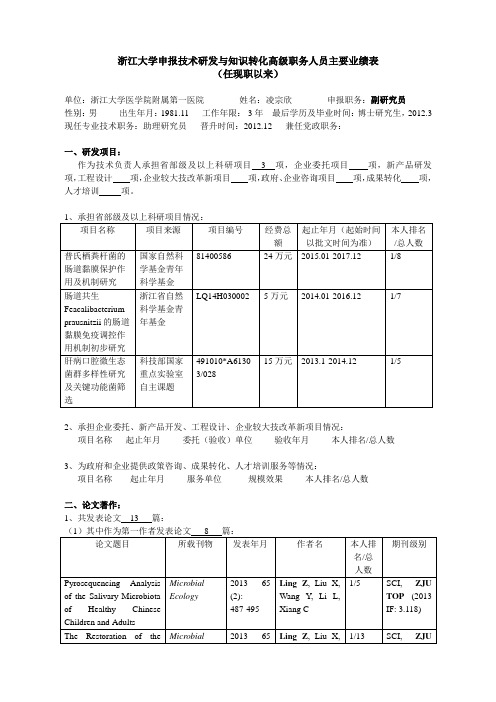
浙江大学申报技术研发与知识转化高级职务人员主要业绩表(任现职以来)单位:浙江大学医学院附属第一医院姓名:凌宗欣申报职务:副研究员性别:男出生年月:1981.11 工作年限:3年最后学历及毕业时间:博士研究生,2012.3 现任专业技术职务:助理研究员晋升时间:2012.12 兼任党政职务:一、研发项目:作为技术负责人承担省部级及以上科研项目 3 项,企业委托项目项,新产品研发项,工程设计项,企业较大技改革新项目项,政府、企业咨询项目项,成果转化项,人才培训项。
2、承担企业委托、新产品开发、工程设计、企业较大技改革新项目情况:项目名称起止年月委托(验收)单位验收年月本人排名/总人数3、为政府和企业提供政策咨询、成果转化、人才培训服务等情况:项目名称起止年月服务单位规模效果本人排名/总人数二、论文著作:1、共发表论文13 篇:(2)以通讯作者或第二作者发表论文篇:2、出版著作共 3 本,总字数为9.39 万字。
其中本人字数在5万字以上的 1 本,3、研究、咨询、验收报告或总结篇。
按照下列格式列出:报告题目本人字数/总字数用途采纳/咨询单位本人排名/总人数三、成果奖励:1、作为负责人或主要完成人获成果奖项,请按下列获奖类别分别列出:2、作为负责人或主要完成人授权发明专利 1 项,国家实用新型专利项:四、社会经济效益(300字以内,重点介绍新产品开发,重大技改、革新项目、工程设计、政策咨询和人才培训等所产生的社会经济效益):申请人专注于感染微生态学研究,率先提出“微生态屏障”理论,系统完成了细菌性阴道病诊断治疗一体化研究,论证了阴道微生态调节剂的优越治疗疗效,率先提出菌群重建是微生态失衡相关疾病的微生物治愈标准,将原有的临床治愈标准进一步推向深入,筛选出具有诊断价值的阴道致病性微生物群落细菌,创立了快速筛查阴道菌群失衡的多重PCR方法,目前已被广泛接受和应用。
针对其他宿主微生态失衡相关疾病如儿童龋病、婴幼儿食物过敏和肝病等,筛选和鉴定出一系列关键功能菌如肝病相关产丁酸普氏栖粪杆菌等,为疾病的发病机制研究、早期无创诊断、疾病靶向治疗、益生菌开发应用提供了重要依据,具有重要的临床意义和应用价值。
浙江大学申报教授研究员职务人员主要业绩任
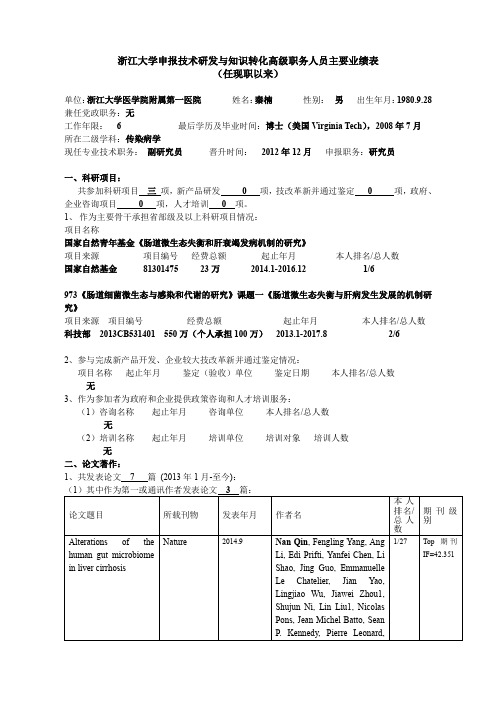
浙江大学申报技术研发与知识转化高级职务人员主要业绩表(任现职以来)单位:浙江大学医学院附属第一医院姓名:秦楠性别:男出生年月:1980.9.28兼任党政职务:无工作年限: 6 最后学历及毕业时间:博士(美国Virginia Tech),2008年7月所在二级学科:传染病学现任专业技术职务:副研究员晋升时间:2012年12月申报职务:研究员一、科研项目:共参加科研项目三项,新产品研发0项,技改革新并通过鉴定0 项,政府、企业咨询项目0项,人才培训0项。
1、作为主要骨干承担省部级及以上科研项目情况:项目名称国家自然青年基金《肠道微生态失衡和肝衰竭发病机制的研究》项目来源项目编号经费总额起止年月本人排名/总人数国家自然基金81301475 23万2014.1-2016.12 1/6973《肠道细菌微生态与感染和代谢的研究》课题一《肠道微生态失衡与肝病发生发展的机制研究》项目来源项目编号经费总额起止年月本人排名/总人数科技部2013CB531401 550万(个人承担100万)2013.1-2017.8 2/62、参与完成新产品开发、企业较大技改革新并通过鉴定情况:项目名称起止年月鉴定(验收)单位鉴定日期本人排名/总人数无3、作为参加者为政府和企业提供政策咨询和人才培训服务:(1)咨询名称起止年月咨询单位本人排名/总人数无(2)培训名称起止年月培训单位培训对象培训人数无二、论文著作:1、共发表论文7 篇(2013年1月-至今):2、出版著作共0 本,总字数为万字。
其中本人字数在5万字以上的本,列出本人字数在5万字以上的著作情况:著作书名著作类型出版年月出版社名称本人字数/总字数3、总结/咨询报告0 篇,总字数为万字。
按照下列格式列出:报告题目总字数用途采纳/咨询单位三、成果奖励:1、共获成果奖0 项,请按下列获奖类别分别列出:项目名称奖励名称授奖单位获奖年月本人排名/总人数(1)国家级奖0 项(2)省部级奖0 项(3)校级成果奖0 项2、作为技术人员获国家发明专利0 项,国家实用新型专利0 项:专利名称专利编号专利单位专利批号本人排名/总人数3、作为参加者获采纳类成果0 项:成果名称采纳部门采纳年月本人排名/总人数(1)国家级采纳类成果0 项(2)省部级采纳类成果0 项四、社会经济效益(新产品开发,重大技改、革新项目、政策咨询和人才培训等所产生的社会经济效益):本人作为骨干承担的973《肠道细菌微生态与感染和代谢的研究》课题一《肠道微生态失衡与肝病发生发展的机制研究》对肝硬化肠道微生态领域有重大影响。
浙江大学申报教授研究员职务人员主要业绩任现职以来
浙江大学申报应用推广研究员职务人员主要业绩(任现职以来)单位:生命科学学院姓名:龚兴国性别:男出生年月:1955,10 兼任党政职务:党总支书记从事应用推广工作年限:15 最后学历及毕业时间:本科1982,7现任专业技术职务:副教授晋升时间:1993,9 申报职务:研究员一、科研项目:共参加科研项目12 项,共计科研经费1058 万元,其中本人完成758 万元,个人实际到校经费640 万元。
1、作为项目负责人承担B类以上项目情况:[项目范围以浙大发人(2006)47号文件为准]项目名称项目来源项目编号经费总额起止年月(起始时间以批文时间为准)1).海藻Fe-SOD,FPC,藻多糖和岩藻甾醇新产品的开发,浙江省重大科技项目(2006C12084),150万(到位42万),2006-2009 ,主持(A类)2).Fe-SOD的系列产品开发重大横向 205万(到位157万) 2006-2008 主持(A类)3).猪血中系列产品的开发重大横向 125万(到位60万) 2006-2009 主持4). β-谷甾醇的精制及其AD、ADD的生物合成横向300万(到位58万)2005-2008 主持2、主持完成新产品开发、企业重大技改革新并通过省部级鉴定 2 项:项目名称起止年月鉴定(验收)单位鉴定日期钝顶螺旋藻高附加值产品的愤激分离2002-2004 浙江省科技厅2004,9,11高纯度荧光藻蓝蛋白的植被方法2002-2004 浙江省科技厅2004,5,23二、论文著作:1、共发表论文78 篇,其中作为第一、第二或通讯作者按照下列期刊分类列出:论文题目所载刊物发表年月本人排名/总人数(1)被SCI、EI收录论文共10 篇1. Shi Y, Wang CH, Gong XG*, Apoptosis-inducing effects of two anthraquinones from Hedyotis diffusa WILLD,BIOLOGICAL & PHARMACEUTICAL BULLETIN Volume: 31 Issue: 6 Pages: 1075-1078 Published: JUN 2008,(SCI IF 1.692)2.Zhou L, Lai ZT, Lu MK,Gong XG*, and Yi Xie(2008),Expression and hydroxylamine cleavage of Thymosin alpha 1 concatemer, Journal of Biomedicine and Biotechnology, vol. 2008, Article ID 736060, 8 pages,.(SCI, IF1.985)3. Lu M, Bi CS, Gong XG*,Chen HM, Sheng XH, Deng TL, Xu KD (2007). Anti-proliferative effects of recombinant iron superoxide dismutase on HepG2 cells via a redox-dependent PI3k/Akt pathway. Applied Microbiology and Biotechnology. 76(1):193-201.(SCI, IF 2.731)他引14. Bao WN, Pan HF, Lu M, Ni Y, Zhang R, Gong XG* (2007). The apoptosis effect of Sarsasapogenin from Anemarrhena asphodeloides on HepG2 human hepatoma cells. Cell Biology International31 (9): 887-892(SCI, IF 1.547),他引15.Lu M,Gong XG*,Lu YW,Gou JJ,Wang CH,Pan YJ (2006). Molecular cloning and functional characterization of a cell-permeable superoxide dismutasetargeted to lung adenocarcinoma cells - Inhibition cell proliferation through the Akt/p27(kip1)pathway. Journal of Biological Chemistry. 281 (19): 13620-13627.(SCI, IF 6.355),他引: 46.Lu M,Gong XG*,Wang CH,Zhen L,Guo jj,Zhang SF (2006). Construction and functional characterization of lung adenocarcinoma targeting SOD. Progress in Biochemistry and Biophysics. 33 (1): 51-58.(SCI,IF 0.228) 7.Lu M,Gong XG*,Yu H,Li JY (2005). Cloning,expression,purification,and characterization of LC-1 ScFv with GFP tag. Journal of Zhejiang University Science B. 6(8):832-837.(EI)8.Gong XG*,Zhong WT,Wu WY (2006). Cloning and GST-fused expression in E. coli of mouse beta-1,4-galactosyltransferase. J Zhejiang Univ Sci.B. 5(2):164-172 (EI)9.Gong XG*,Yu H,Xu FH, Tan HS (2005). Construction and expression of fusion gene of LC-1 ScFv and GFP. Journal of Zhejiang University Engineering Science. 39(5): 751-755.(EI)10.张俊彦,谢捷,周远,龚兴国* (2005). v-Src蛋白在大肠杆菌中的高效表达、纯化及其活性分析,中国药学杂志. 40(12):943-946.(EI)(2)国内一级刊物论文共15 篇1.Gong XG*,Ji J,Xie J,Zhou Y,Zhang JY,Zhong WT (2006). Expression,purification,and bioactivity of GST-fused v-Src from a bacterial expression system. J Zhejiang Univ Sci B. 7(1):13-19. (EI)2.陈小强,史锋,龚兴国* (2004).R-藻红蛋白的结构、功能及其应用,细胞生物学杂志.26(4):399-4033.洪美亚,龚兴国* (2006). 胞内抗体及其研究进展, 细胞生物学杂志,2006,28(3):425-4284.张锐,曾冬云,龚兴国* (2006). 羊栖菜多糖的提取工艺研究,中国食品学报.6(3):14-185.张锐,曾冬云,龚兴国* (2006). 羊栖菜褐藻糖胶的分离纯化和组分性质研究,中国食品学报.6(5):22-276.金慧,钟文涛,龚兴国* (2005).β-1,4半乳糖基转移酶Ⅰ在G蛋白介导的顶体反应中的作用,中国病理生理杂志. 21(7):1445-14477.许宝清,李继喜,龚兴国* (2006). 促分裂原活化蛋白激酶磷酸酶,细胞生物学杂志.27(4):387-3908.章申峰,龚兴国* (2005).光动力学疗法对肿瘤的作用机制及影响因素,细胞生物学杂志. 27(4):395-3999.秦桂香,龚兴国*,纪静 (2005). 胸腺素α1的研究进展,细胞生物学杂志. 27(6):521-52410.金国祥,龚兴国*,黄勤,费俭 (2004). 表达β-半乳糖苷酶的gal B16肿瘤模型的建立及其在肿瘤DNA疫苗研究的应用,实验生物学报. 37(4):339-34311.龚兴国*,于红(2004). 热休克蛋白60的研究进展,中国病理生理杂志. 20(11):2151-215412.谢毅,龚兴国* (2004).G蛋白偶联受体激酶的调控,细胞生物学杂志. 26(5):509-51213.钟文涛,龚兴国* (2004).大分子拥挤对DNA结构的影响,细胞生物学杂志. 26(6):583-58614.王华祖,龚兴国* (2003). 蛋白激酶B的研究进展,中国病理生理杂志.19(11):1521-152615.谢捷,龚兴国* (2003). Src蛋白的研究进展,中国病理生理杂志19(8):1119-1124(3)浙大学报相同等级刊物论文共 4 篇1.陈小强,龚兴国,梁倩,史锋,陈勇 (2005). 三种藻胆蛋白对人乳腺癌Bcap-37细胞的光动力杀伤效果,浙江大学学报(理学版).32(4):438-4412.卢敏,秦桂香,龚兴国*,郭建军,钟文涛 (2005) 钝顶螺旋藻Fe-SOD的结构与进化,浙江大学学报(理学版).32(4):442-4473.郭建军,龚兴国*,卢敏 (2005). Fe-SOD表达载体的构建及在及其在大肠杆菌中的融合表达,浙江大学学报(理学版).31(6):674-6784.汪辰卉,史影,龚兴国*,(2007)体外Src蛋白酪氨酸激酶抑制剂筛选模型的建立,浙江大学学报(理学版).33(6):646-650(4)国际一般学术刊物论文共篇(5)国内二级刊物论文共 1 篇1.洪美亚,钟文涛,龚兴国* (2005).窖蛋白的生物学功能及其在疾病中的作用,生命的化学.25(2):150-1522、出版著作共 1 本,总字数为万字。
浙江大学申报教授(研究员)职务人员主要业绩(任现职以来)
4)动脉瘤性蛛网膜下腔出血的早期诊治规范化研究卫生部省部共建项目项目编号:N200905032009.07—2011.12 15万元主持
5)动脉瘤性蛛网膜下腔出血急诊脑血管造影及栓塞治疗绿色通道的建立
浙江省科技厅项目项目编号:N20080354 2008.01—2010.12 10万元主持
6)蔓荆子活性成分vitexicarpin对人侵袭性分泌性垂体瘤的治疗作用及机制研究
省中医药管理局重点项目项目编号:N200905062009.01—2012.127万元
7)动脉瘤性蛛网膜下腔出血个体化治疗策略及预后评估研究
临床医学七年制硕士2004级:严锋王哲培高连升
临床医学七年制硕士2005级:谷驰陈敬寅李仕尉
临床医学七年制硕士2006级:莫杭波
临床医学七年制硕士2007级:曹生龙俞晓波严志远
临床医学七年制硕士2008级:叶清煌徐航哲吕骏晖
临床医学七年制硕士2009级:章乃鼎郭雨帆
临床医学国际留学生2011级硕士:苏德
2)Inhibiting HIF-1α by 2ME2 ameliorates early brain injury after experimental subarachnoid hemorrhage in rats. Chen Wu,Gao Chen.Biochem Biophys Res Commun.2013 Aug 2;437(3):469-74(影响因子:2.406)通讯作者
2、作为项目负责人承担项目:
项目名称项目来源项目编号经费总额到款经费起止年月(起始时间以批文时间为准)
浙江大学申报教授(研究员)职务人员主要业绩(任现职以来)
实验技术系列
高级专业技术职务岗位申请表
姓名:张钊
现任职务:工程师
拟申请职务:高级实验师
申请日期:2019年9月4日
填表说明
1、申报实验技术系列高级专业技术职务的人员,根据学校公布的任职条件,限填满足或高于申报岗位评审条件的业绩。
2、关于格式。
填入的文字,原则上使用宋体五号字,行距为固定值20磅;日期格式为20**.*-20**.*;第
五、六部分,单独成页。
3、关于第一部分,主要填写申报人的基本情况。
(1)晋职外语,符合免试条件的人员填写“免”字;参加考试并符合岗位申报要求的人员填写“合格”两字。
(2)学习和工作简历部分,由远及近填写;学习经历从大学开始。
4、关于第二部分,主要阐述申报人任现职以来的标志性学术成果或实验技术突出成就。
5、关于第三部分,主要填写申报人任现职以来各项业绩情况。
从事大型仪器设备操作与维护为主的人员,需填写仪器开发维护信息,对实验教学方面不做要求。
6、关于第四部分,主要阐述申报人任现职以来的其他突出业绩、社会兼职及荣誉等情况。
7、关于第五部分,主要阐述申报人聘任成功后5年内的工作思路、预期目标和工作计划。
预期目标要求按照申报岗位类型写明业绩的具体量化目标;工作计划从2020年起,按照年度分列。
8、第六部分为同行专家鉴定表,申报人填写代表作题目及以上部分内容。
9、本表格的设计已经充分考虑和认证,不得随意改变和增删表格任意部分。
浙江大学宁波理工学院实验技术系列高级专业技术职务岗位申请表
(任现职以来业绩)
11。
浙江大学申报教授(研究员)职务人员主要业绩(任现职以来)
浙江大学申报卫生技术正高级职务人员主要业绩(任现职以来)医院:浙江大学医学院附属妇产科医院科室:生殖遗传科姓名:翁炳焕性别:男出生年月:1964.1.24 兼任党政职务:最后学历及毕业时间: 2005年获本科学历;2013年获医学硕士学位继续教育:合格现任专业技术职务及晋升时间:2000.12副主任技师拟升职务:主任技师一、临床工作:每年完成临床工作 52 周,其中普通门诊次,专家门诊次,主持查房次,参加院内外会诊次。
二、教学工作:1、共开设课程门,授课时数共计学时。
其中必修课门,必修课开课情况如下:教学年度课程名称授课对象学生数周学时×周数考核情况2、承担临床教学指导教师工作情况:教学年度课程名称授课对象学生数周数考核情况3、指导硕士生名,协助指导博士生人(请列出研究生姓名、专业、年级)。
三、科研项目1、共参加科研项目 1 项,共计科研经费 37 万元,其中本人完成 37 万元。
2、作为项目负责人承担项目:(1)国家级项目项(2)省部级项目 1 项项目名称:胎儿染色体先天缺陷产前诊断关键技术的改良研究项目来源:浙江省科技厅公益技术研究社会发展项目项目编号:2012C33052经费总额:37万元起止年月(起始时间以批文时间为准):2012.1-2013.6本人排名/总人数:1/6(3)厅局级项目项申报主任护师还可填写作为主参(前3名)人员参与项目:(4)省部级及以上项目项(5)厅局级项目项四、发表论文:共发表论文 3 篇,其中作为第一、通讯作者按照下列期刊分类列出:(1)被SCI收录论文共 1 篇论文题目所载刊物发表年月本人排名/总人数Binghuan Weng, Xiao Li. An external quality assessment scheme for prenataldetection of rare chromosomal abnormalities. Clinica Chimica Acta 413 (2012)1721–1724.(F2.5)(2)国内一级刊物论文共 2 篇论文题目所载刊物发表年月本人排名/总人数①翁炳焕,任宇珂,吕时铭. 产前诊断中染色体核型分析的质量控制. 中华医院管理学杂志,2008,24(3):216-217②翁炳焕,蔡剑平,王绪敏,等.染色体异常核型淋巴细胞建系及其在染色体分析室间质评中的应用. 中华医学遗传学杂志,2007,24(6):689-691.申报主任护师还可填写:(3)国内核心期刊论文共篇五、成果奖励:共获成果奖 2 项,其中教材奖项,教学成果奖项,科研成果奖 2 项,请按下列获奖类别分别列出:项目名称奖励名称授奖单位获奖年月本人排名/总人数(1)国家级奖 1 项项目名称:《提高出生人口质量的生殖技术创建、体系优化与临床推广应用》奖励名称:国家科学技术进步奖二等奖授奖单位:中华人民共和国国务院获奖年月:2010年11月29日本人排名:10/10(2)省部级一等奖 1 项项目名称:《阻断出生缺陷、促进子代健康关键技术体系的创建与推广应用》奖励名称:浙江省科学技术进步奖一等奖授奖单位:浙江省人民政府获奖年月:2010年度本人排名:12/13六、主要工作业绩综述:反映临床技术水平、诊断符合率、抢救危重病人、独立解决疑难问题的能力等。
- 1、下载文档前请自行甄别文档内容的完整性,平台不提供额外的编辑、内容补充、找答案等附加服务。
- 2、"仅部分预览"的文档,不可在线预览部分如存在完整性等问题,可反馈申请退款(可完整预览的文档不适用该条件!)。
- 3、如文档侵犯您的权益,请联系客服反馈,我们会尽快为您处理(人工客服工作时间:9:00-18:30)。
浙江大学学院(系)拟定教授职务任职条件
学科:军事理论
教学:
(包括基本课程教学任务、教学质量;学生指导及思想政治教育工作等)
近五年担任本科生课程1门,课时数达全院同类教师平均数以上,教学质量考核优良。
成果:
(包括学术论著质量的要求;获奖情况;专利及转化要求等)
1.以第一、通讯作者在SSCI、SCI上发表论文1篇并国内一级期刊4篇或权威期刊1篇并国内一级期刊6篇或SSCI、SCI论文2篇或权威期刊3篇(申报研究员,一级期刊对应增加2篇。)。独立出版高水平学术专著1部或以第一主编主持出版省级及以上通用教材2本。
2.获省部级三等(含)以上奖励(包括教学成果奖)或所指导学生的科研成果获全国性竞赛三等(含)以上奖励。体育系术科教师所带运动队或运动员训练时间达一年以上且运动成绩或技术水平有明显提高,在奥运会、世界锦标赛、亚运会、世界大学生运动会、全运会等比赛中取得集体项目前8名或个人单项前3名;在全国大学生运动会以上级别比赛中取得集体项目前三名或个人单项冠军或在全国大学生单项锦标赛以上级别比赛中取得集体项目第一或个人单项冠军3项。
1.以第一、通讯作者在SSCI、SCI上发表论文1篇并国内一级期刊1篇或权威期刊1篇并国内一级期刊2篇(无SSCI、SCI或权威期刊论文,增加国内一级期刊2篇)。独立出版高水平学术专著1部或以第一主编主持出版省级及以上通用教材2本。
2.获省部级三等(含)以上奖励(包括教学成果奖)1项或所指导学生的科研成果获全国性竞赛三等(含)以上奖励1项。
项目:
(主持国家级、省部级和重大横向等项目的类别、数量及经费等)
主持国家级项目1项或省部级重点项目1项或国家级精品课程1项或横向项目单个合同50万及以上(已到款80%及以上)。体育学术科教师负责省部级一般项目2项或省级精品课程2项或省部级一般项目1项和省级精品课程1项。
社会服务:
(含校内外服务)
1、积极参与学科建设、学生思政、社会服务等工作(需所在部门意见)。
浙江大学学院(系)拟定教授职务任职条件
学科:教育学、体育学
教学:
(包括基本课程教学任务、教学质量;学生指导及思想政治教 Nhomakorabea工作等)
近五年担任本科生课程2门及以上,课时数达全院同类教师平均数以上,教学质量考核优良(申报研究员不作要求),指导研究生3名及以上。
成果:
(包括学术论著质量的要求;获奖情况;专利及转化要求等)
2、海外合作交流(需达到其中2项或综合水平达到相应要求)
①在国际学术会议上作大会报告1次或组织召开国际学术会议1次及以上;
②主持国际合作项目1项及以上;
③在海外有影响力的出版机构出版学术著作或教材1本;
④在国际学术性组织(如协会、杂志社等)兼职;
⑤开设全英文课程1门及以上;
⑥赴境外著名高校(含学术机构)进修或访学6个月以上。
项目:
(主持国家级、省部级和重大横向等项目的类别、数量及经费等)
负责省部级一般及以上项目1项或省级及以上精品课程1项。
社会服务:
(含校内外服务)
1、积极参与学科建设、学生社团、社会服务等工作(需所在部门意见)。
2、海外合作交流(可任选其中1项)
①在国际学术会议上作大会报告1次或参加境外国际学术会议2次及以上;
②主持国际合作项目1项及以上;
③在海外有影响力的出版机构出版学术著作或教材1本;
④在国际学术性组织(如协会、杂志社等)兼职;
⑤赴境外著名高校(含学术机构)进修或访学6个月以上。
注:教育学院高级职称评审要考虑代表作在该研究领域中的影响力,并参考国际同行水平评估的结果。
